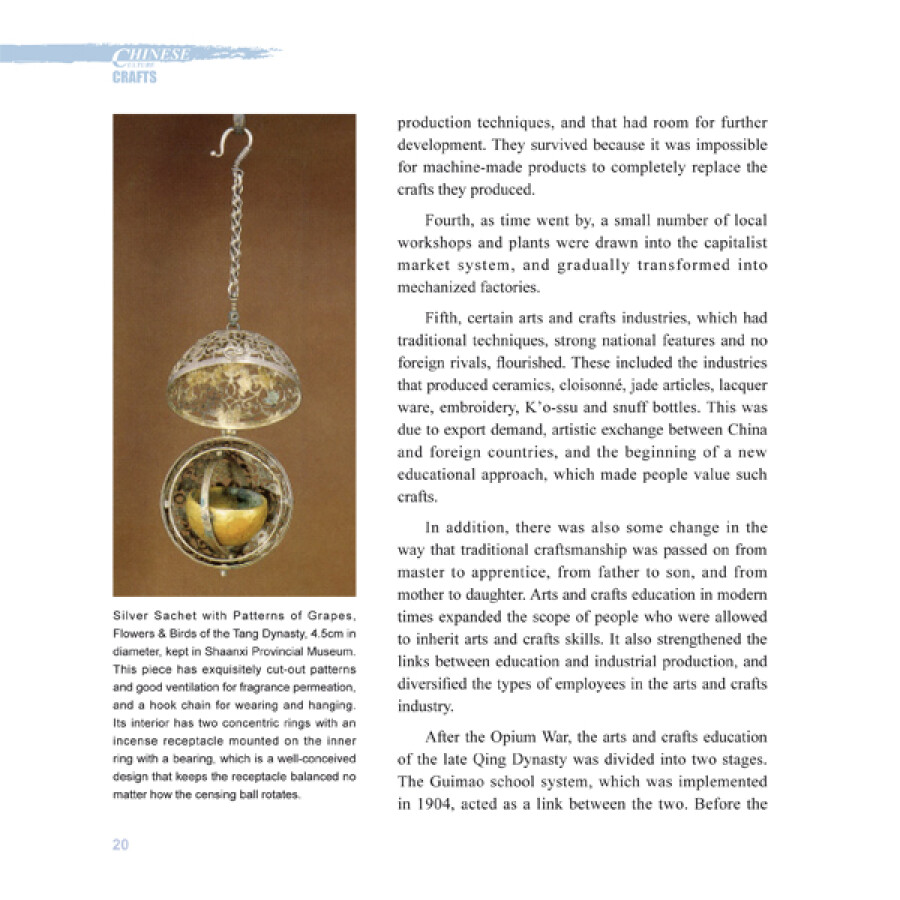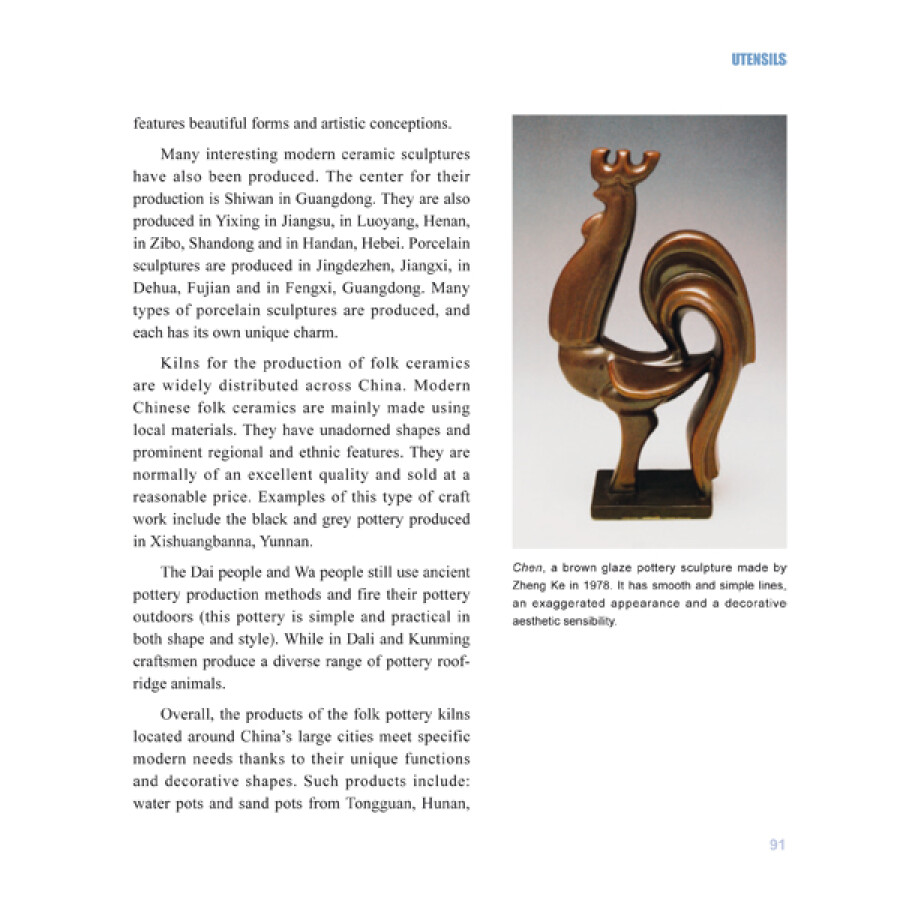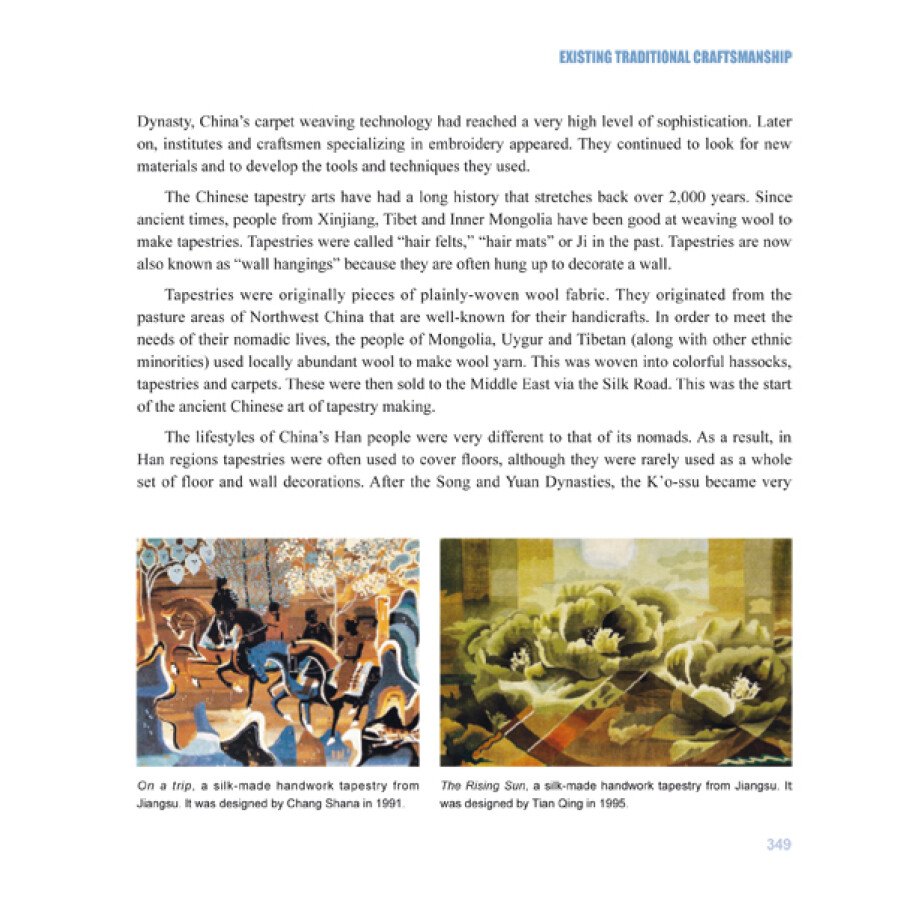Contents
Preface
Craft Culture
The Transformation of Chinese Contemporary Arts and Crafts
The Development of Chinese Contemporary Arts and Crafts
Chinese Contemporary Handcrafts - Part of the Country’s Intangible Cultural Heritage
Sages’ Creations: Traditional Chinese Crafts and Their Tales
Utensils
Ceramics
Bronze Vessels
Lacquer Ware
Costume
Fabrics
Embroidery
Printing and Dyeing
Display
Furniture
Enameled Glassware Inlaid With Gold and Silver
Bamboo-Carving, Wood-Carving, Ivory- and Horn-Carving
Decoration
Jade Ware
New Year Pictures
Paper-cut
Folk Arts
Folk Toys
Kites
Puppets
Shadow Play
Commerce
Shop Signs and Huangzi
Packaging
Existing Traditional Craftsmanship
Folk Tools
Fiber Arts
Bamboo Crafts
Appendix
Enameled Glassware Inlaid With Gold and Silver
Gold and silver ware
Gold and silver ware are utensils and ornaments made using the precious metals as their basic materials. China’s gold and silver ware is well known for its exquisite craftsmanship. It comes in many different varieties and is perceived as a symbol of wealth owing to its value, its rare raw materials, its bright luster and luxurious texture and finish.
In terms of its physical properties, gold is resistant to corrosion, oxidation and high temperatures. It does not rust and can be extruded and worked easily. It is very precious.
The main processes involved in making gold ware include smelting, mold casting, hammering, welding, “busting beads,” engraving, spinning, weaving, filigree making and embedding. Some of these techniques developed from the technology used to make bronze items, others are unique to the manufacture of gold ware. For example, bursting beads involves dropping molten gold into warm water. This produces perfect gold beads, which can then be bonded or linked toegther.
Silver has inferior physical properties than gold, and is more plentiful, it is therefore much less precious. Chinese silver ware appeared later than gold ware, and all its crafts are derived from those used to male gold items.
From the very start, gold and silver ware has been seen as having artistic and aesthetic value. The earliest existing Chinese gold article was made in the Shang Dynasty, over 3,000 years ago. Early gold and silver articles were mostly ornaments. They were characterized by their simplicity, and were small and exquisite in shape. They were unusually carved with distinctive local designs. Gold articles from the time of the Shang Dynasty were mainly gold and silver foils, gold leaves and plaques. These were mainly used for decorating furniture. In northern and northwestern areas, however, early gold articles were mainly worn as jewelry. One particularly attractive early gold item is a unique gold mask and scepter that was unearthed from the Sanxingdui Early Sichuan Cultural Site, in Guanghan, Sichuan. The growth of bronze crafts in the Shang and Zhou Dynasties laid a solid technical foundation for the development of gold and silver ware. Meantime, the development of jade carving and lacquer ware also promoted the development of gold and silver crafts in China. These crafts experienced peaks during the Spring and Autumn Period, the Warring States Era, the Qin and Han Dynasties, the Sui and Tang Dynasties, and the Ming and Qing Dynasties.
In the Spring and Autumn Period and Warring States Era, gold and silver craftsmanship developed remarkably. Gold and silver ware was produced in a wide variety of styles and to a high quality and was widely distributed. It had a vivid style and sophistication.
Silvering and gold plating was the most typical craft of time. This dated from the middle of Spring and Autumn Period, flourished in the Warring States Era, and gradually declined after the Western Han Dynasty. This decoration technique involved the following steps: first, a recessed pattern was either cast or carved on the surface of a piece of bronze ware. Then, gold and silver wires and plaques were firmly secured to the item. Finally the whole piece was ground and polished with stone. This highlighted the pattern and inscription.
Gold and silver ware of the time included practical utensils (such as gold pots, gold spoons, gold cups and silver plates), animal plaques, spikes, ornaments, adornments (gold crowns, gold belt hooks, gold necklaces and gold earrings) and other solid gold articles. The silver plate for the King of Chu (collected in the Palace Museum) is one of the earliest pieces of Chinese silver ware ever discovered.
In the Han Dynasty, gold and silver articles were used by people in the upper echelons of society. These items were exquisitely modeled and many of them featured finely crafted filigree decorations. Filigree techniques included weaving, piling and binding.
By the time of the Han Dynasty fine gold craftsmanship had reached a mature stage of development and had finally broken away from the traditional techniques of bronze craft. The techniques of wrapping, embedding, plating and polishing were still used to decorate copper and iron items with gold and silver. However, gold foils or grains were also used to decorate lacquer ware and silk fabrics.
During the Six Dynasties, as contact with foreign countries increased and Buddhism began to spread across China, gold and silver began to be used to make Buddhist articles. Some gold and silver articles at that time had designs that reflected the characteristics of China’s northern nomadic people or of the Persian Sassanian Empire.


